light KIA K900 2017 Features and Functions Guide
[x] Cancel search | Manufacturer: KIA, Model Year: 2017, Model line: K900, Model: KIA K900 2017Pages: 62, PDF Size: 6.38 MB
Page 3 of 62
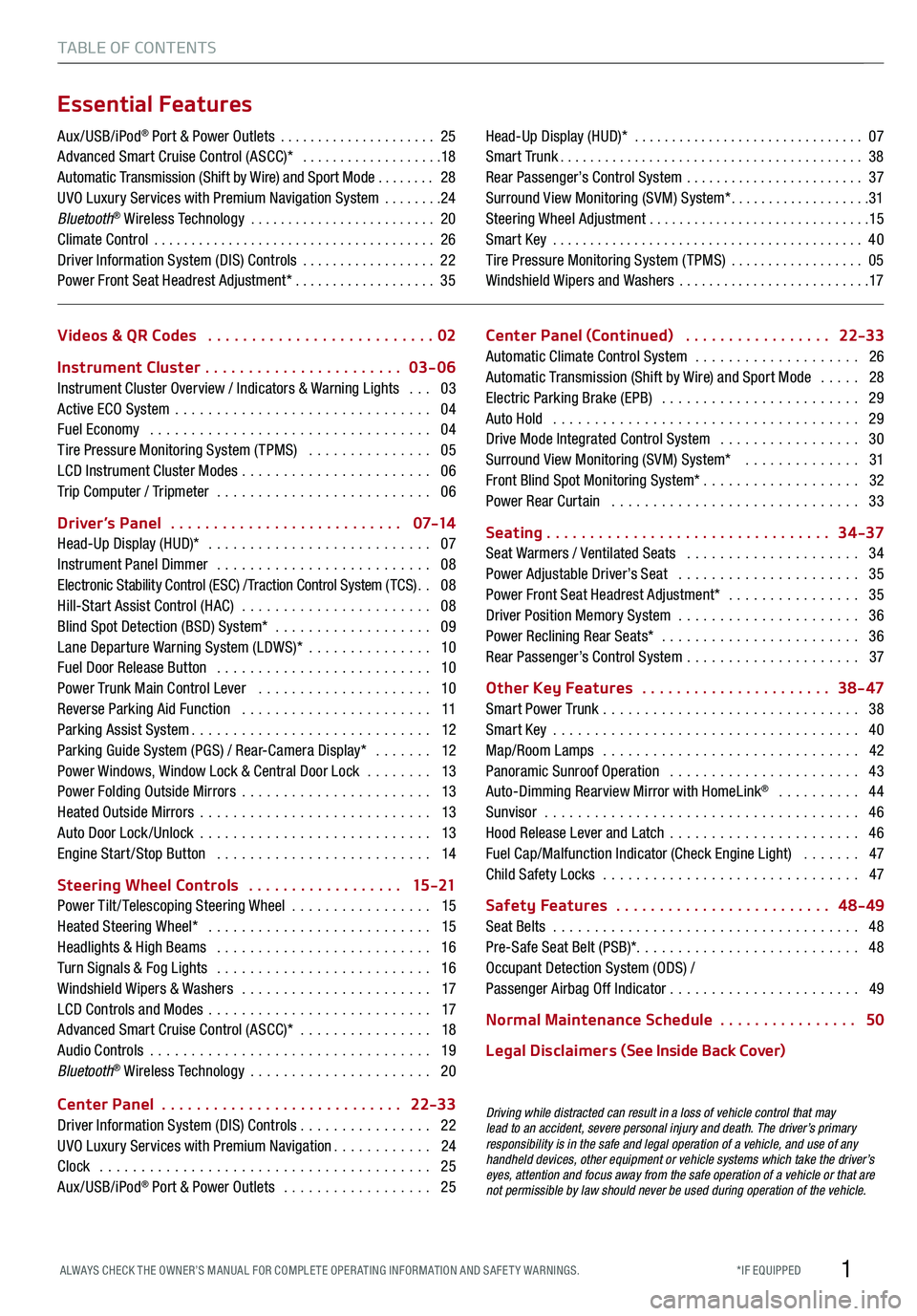
1
TABLE OF CONTENTS
Videos & QR Codes ..........................02
Instrument Cluster
.......................03-06
Instrument Cluster Overview / Indicators & Warning Lights ...03
Active ECO System ...............................04
Fuel Economy ..................................04
Tire Pressure Monitoring System (TPMS) ...............05
LCD Instrument Cluster Modes .......................06
Trip Computer / Tripmeter ..........................06
Driver’s Panel
...........................0 7-14
Head-Up Display (HUD)* ...........................07
Instrument Panel Dimmer ..........................08
Electronic Stability Control (ESC) / Traction Control System ( TCS) ..08
Hill-Start Assist Control (HAC) .......................08
Blind Spot Detection (BSD) System* ...................09
Lane Departure Warning System (LDWS)* ...............10
Fuel Door Release Button ..........................10
Power Trunk Main Control Lever .....................10
Reverse Parking Aid Function .......................11
Parking Assist System .............................12
Parking Guide System (PGS) / Rear-Camera Display* .......12
Power Windows, Window Lock & Central Door Lock ........13
Power Folding Outside Mirrors .......................13
Heated Outside Mirrors ............................13
Auto Door Lock /Unlock ............................13
Engine Start /Stop Button ..........................14
Steering Wheel Controls
..................15 -21
Power Tilt/ Telescoping Steering Wheel .................15
Heated Steering Wheel* ...........................15
Headlights & High Beams ..........................16
Turn Signals & Fog Lights ..........................16
Windshield Wipers & Washers .......................17
LCD Controls and Modes ...........................17
Advanced Smart Cruise Control (ASCC)* ................18
Audio Controls ..................................19
Bluetooth® Wireless Technology ......................20
Center Panel
............................22-33
Driver Information System (DIS) Controls ................ 22
UVO Luxury Services with Premium Navigation
............24
Clock ........................................25
Aux/USB/iPod® Port & Power Outlets ..................25 Center Panel (Continued)
.................22-33
Automatic Climate Control System ....................26
Automatic Transmission (Shift by Wire) and Sport Mode .....28
Electric Parking Brake (EPB) ........................29
Auto Hold .....................................29
Drive Mode Integrated Control System .................30
Surround View Monitoring (SVM) System* ..............31
Front Blind Spot Monitoring System* ...................32
Power Rear Curtain ..............................33
Seating
.................................34-37
Seat Warmers / Ventilated Seats .....................34
Power Adjustable Driver’s Seat ......................35
Power Front Seat Headrest Adjustment* ................35
Driver Position Memory System ......................36
Power Reclining Rear Seats* ........................ 36
Rear Passenger’s Control System ..................... 37
Other Key Features
......................38 - 47
Smart Power Trunk ...............................38
Smart Key .....................................40
Map/Room Lamps ...............................42
Panoramic Sunroof Operation .......................43
Auto-Dimming Rearview Mirror with HomeLink® .......... 44
Sunvisor ......................................46
Hood Release Lever and Latch .......................46
Fuel Cap/Malfunction Indicator (Check Engine Light) .......47
Child Safety Locks ...............................47
Safety Features
.........................48-49
Seat Belts .....................................48
Pre-Safe Seat Belt (PSB)* ........................... 48
Occupant Detection System (ODS) /
Passenger Airbag Off Indicator
....................... 49
Normal Maintenance Schedule
................50
L ega l D i sc la ime r s (See Inside Back Cover)
Driving while distracted can result in a loss of vehicle control that may
lead to an accident, severe personal injury and death. The driver’s primary
responsibility is in the safe and legal operation of a vehicle, and use of any
handheld devices, other equipment or vehicle systems which take the driver’s
eyes, attention and focus away from the safe operation of a vehicle or that are
not permissible by law should never be used during operation of the vehicle.
Aux/USB/iPod® Port & Power Outlets .....................25
Advanced Smart Cruise Control (ASCC)* ...................18
Automatic Transmission (Shift by Wire) and Sport Mode ........ 28
UVO Luxury Services with Premium Navigation System ........24
Bluetooth® Wireless Technology .........................20
Climate Control ......................................26
Driver Information System (DIS) Controls ..................22
Power Front Seat Headrest Adjustment* ...................35 Head-Up Display (HUD)*
...............................07
Smart Trunk .........................................38
Rear Passenger’s Control System ........................37
Surround View Monitoring (SVM) System* ...................31
Steering Wheel Adjustment ..............................15
Smart Key ..........................................40
Tire Pressure Monitoring System (TPMS) ..................05
Windshield Wipers and Washers ..........................17
Essential Features
*IF EQUIPPED
ALWAYS CHECK THE OWNER’S MANUAL FOR COMPLE TE OPER ATING INFORMATION AND SAFE T Y WARNINGS.
Page 5 of 62
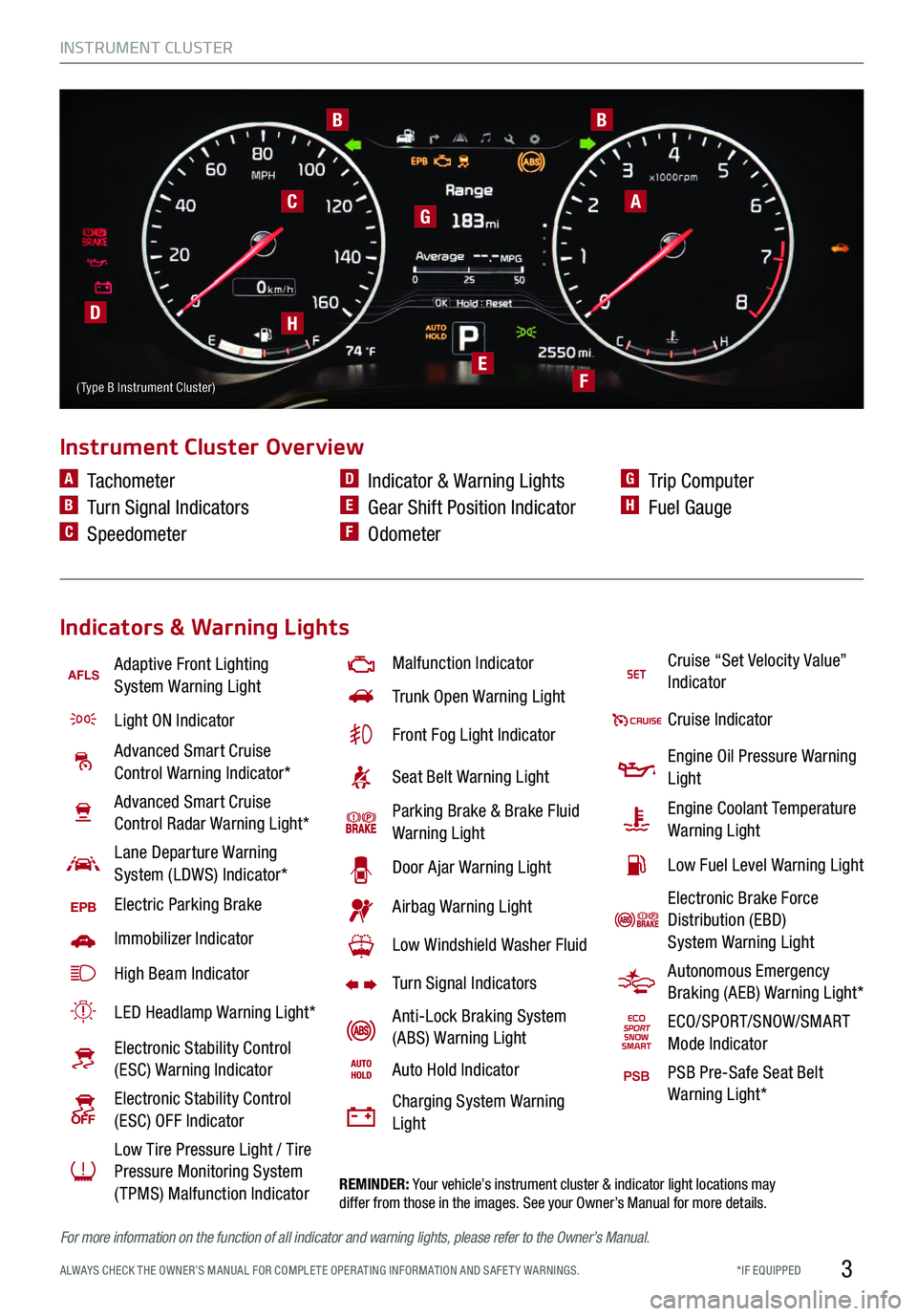
3
www.KuTechVideos.com/kh13/2017
AFLSAdaptive Front Lighting System Warning Light
Light ON Indicator
Advanced Smart Cruise Control Warning Indicator*
Advanced Smart Cruise
Control Radar Warning Light*
Lane Departure Warning
System (LDWS) Indicator*
EPBElectric Parking Brake
Immobilizer Indicator
High Beam Indicator
LED Headlamp Warning Light*
Electronic Stability Control (ESC) Warning Indicator
Electronic Stability Control (ESC) OFF Indicator
Low Tire Pressure Light / Tire
Pressure Monitoring System
(TPMS) Malfunction Indicator
Malfunction Indicator
Trunk Open Warning Light
Front Fog Light Indicator
Seat Belt Warning Light
Parking Brake & Brake Fluid Warning Light
Door Ajar Warning Light
Airbag Warning Light
Low Windshield Washer Fluid
Turn Signal Indicators
Anti-Lock Braking System
(ABS) Warning Light
Auto Hold Indicator
Charging System Warning
Light
REMINDER: Your vehicle’s instrument cluster & indicator light locations may
differ from those in the images. See your Owner’s Manual for more details.
Instrument Cluster Overview
Indicators & Warning Lights
A Tachometer
B Turn Signal Indicators
C Speedometer
D Indicator & Warning Lights
E Gear Shift Position Indicator
F Odometer
G Trip Computer
H Fuel Gauge
A
BB
C
D
E
H
G
F
Cruise “Set Velocity Value” Indicator
Cruise Indicator
Engine Oil Pressure Warning Light
Engine Coolant Temperature Warning Light
Low Fuel Level Warning Light
Electronic Brake Force Distribution (EBD)
System Warning Light
Autonomous Emergency Braking (AEB) Warning Light*
ECO/SPORT/SNOW/SMART Mode Indicator
PSB Pre-Safe Seat Belt Warning Light*
( Type B Instrument Cluster)
For more information on the function of all indicator and warning lights, please refer to the Owner’s Manual.
INSTRUMENT CLUSTER
*IF EQUIPPED
ALWAYS CHECK THE OWNER’S MANUAL FOR COMPLE TE OPER ATING INFORMATION AND SAFE T Y WARNINGS.
Page 6 of 62
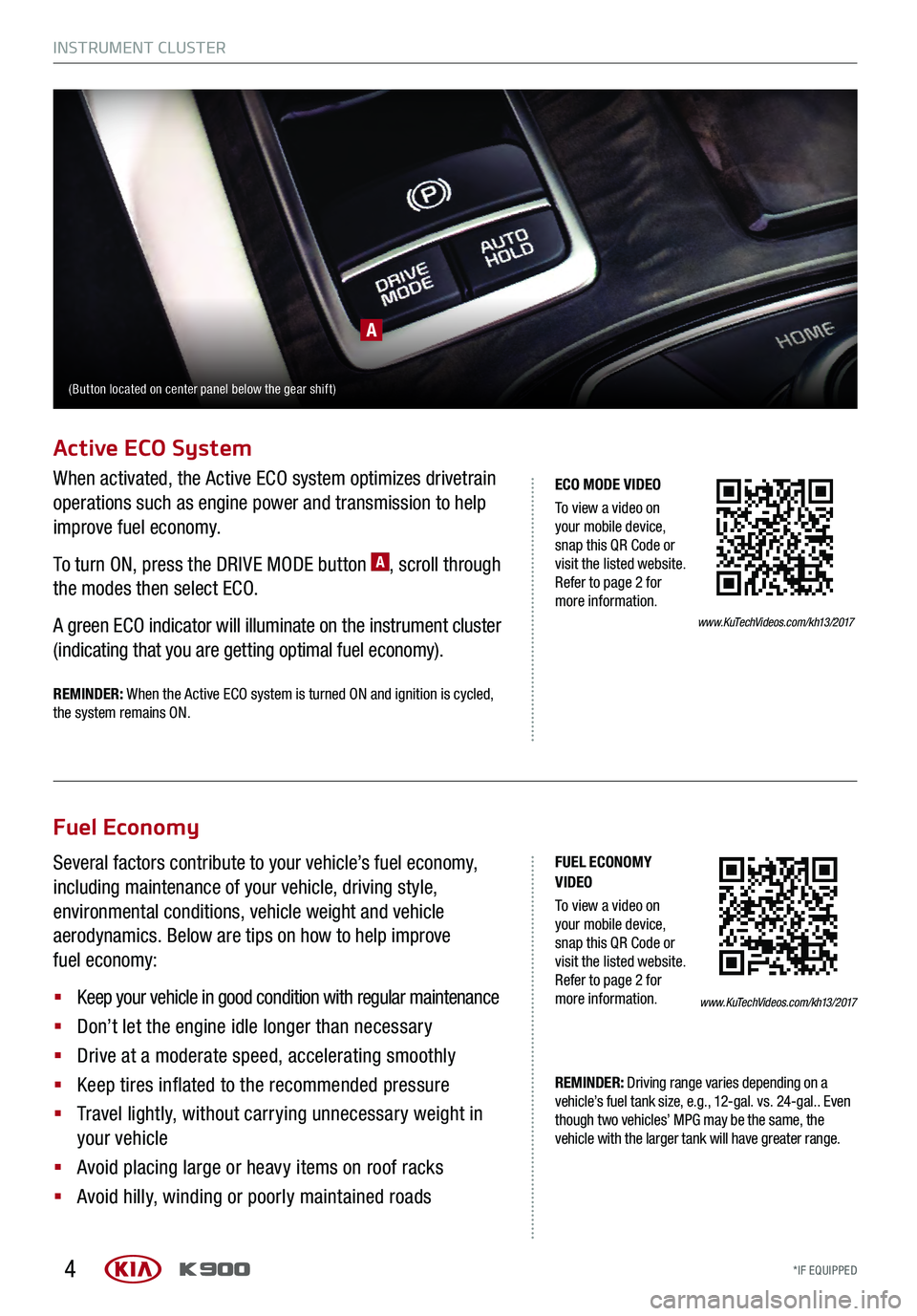
4
Fuel Economy
Several factors contribute to your vehicle’s fuel economy,
including maintenance of your vehicle, driving style,
environmental conditions, vehicle weight and vehicle
aerodynamics. Below are tips on how to help improve
fuel economy:
§
Keep your vehicle in good condition with regular maintenance
§
Don’t let the engine idle longer than necessary
§
Drive at a moderate speed, accelerating smoothly
§
Keep tires inflated to the recommended pressure
§
Travel lightly, without carrying unnecessary weight in
your vehicle
§
Avoid placing large or heavy items on roof racks
§
Avoid hilly, winding or poorly maintained roads
REMINDER: Driving range varies depending on a
vehicle’s fuel tank size, e.g. , 12-gal. vs. 24-gal.. Even
though two vehicles’ MPG may be the same , the
vehicle with the larger tank will have greater range.
www.KuTechVideos.com/kh13/2017
FUEL ECONOMY
VIDEO
To view a video on
your mobile device,
snap this QR Code or
visit the listed website.
Refer to page 2 for
more information.
Active ECO System
When activated, the Active ECO system optimizes drivetrain
operations such as engine power and transmission to help
improve fuel economy.
To turn ON, press the DRIVE MODE button
A, scroll through
the modes then select ECO.
A green ECO indicator will illuminate on the instrument cluster
(indicating that you are getting optimal fuel economy).
www.KuTechVideos.com/kh13/2017
ECO MODE VIDEO
To view a video on
your mobile device,
snap this QR Code or
visit the listed website.
Refer to page 2 for
more information.
A
(Button located on center panel below the gear shift)
REMINDER: When the Active ECO system is turned ON and ignition is cycled,
the system remains ON.
INSTRUMENT CLUSTER
*IF EQUIPPED
INSTRUMENT CLUSTER
*IF EQUIPPED
Page 7 of 62
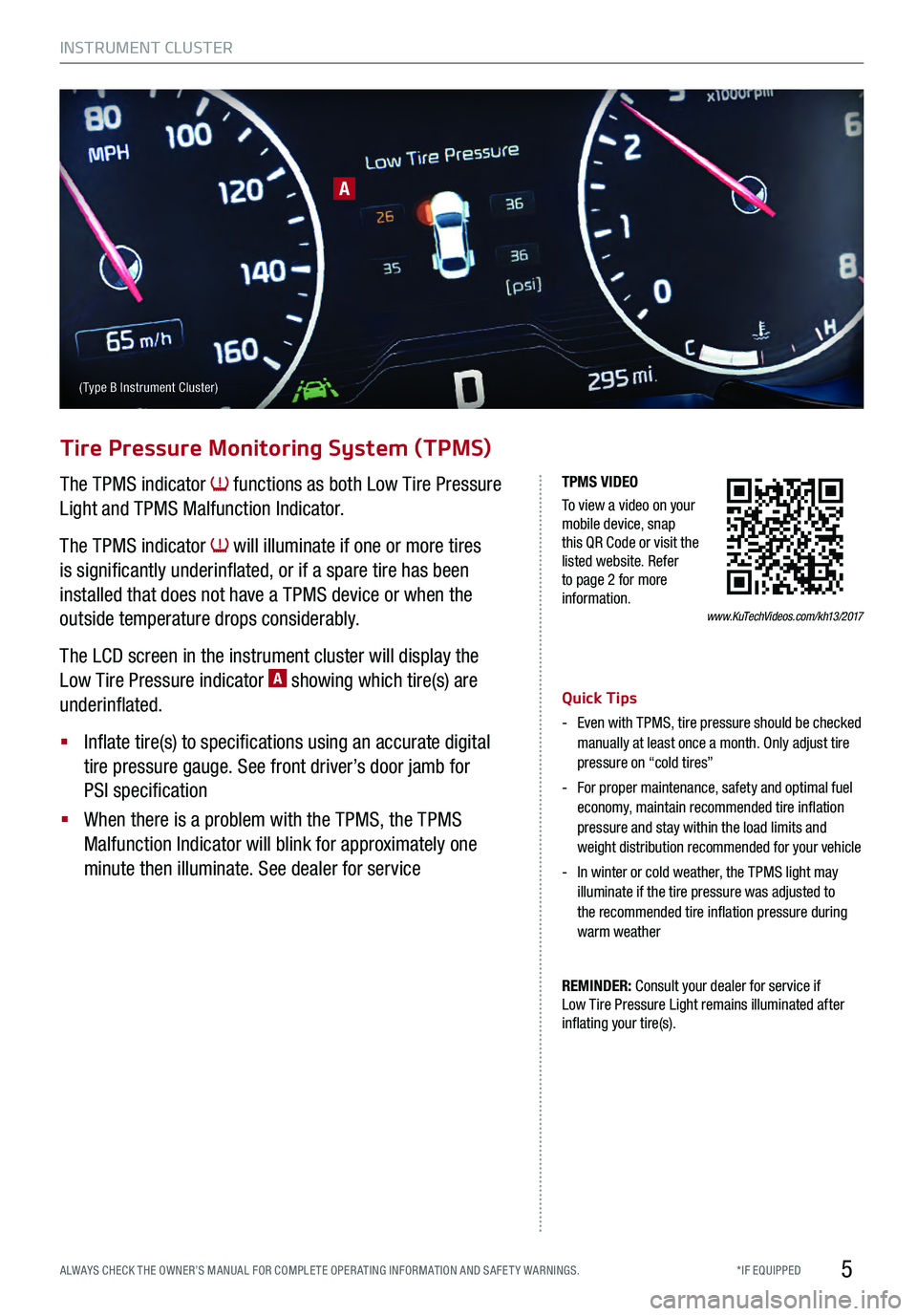
5
REMINDER: Consult your dealer for service if
Low Tire Pressure Light remains illuminated after
inflating your tire(s). Quick Tips
- Even with TPMS, tire pressure should be checked manually at least once a month. Only adjust tire
pressure on “cold tires”
- For proper maintenance, safety and optimal fuel economy, maintain recommended tire inflation
pressure and stay within the load limits and
weight distribution recommended for your vehicle
- In winter or cold weather, the TPMS light may illuminate if the tire pressure was adjusted to
the recommended tire inflation pressure during
warm weather
The TPMS indicator functions as both Low Tire Pressure
Light and TPMS Malfunction Indicator.
The TPMS indicator
will illuminate if one or more tires
is significantly underinflated, or if a spare tire has been
installed that does not have a TPMS device or when the
outside temperature drops considerably.
The LCD screen in the instrument cluster will display the
Low Tire Pressure indicator
A showing which tire(s) are
underinflated.
§
Inflate tire(s) to specifications using an accurate digital
tire pressure gauge. See front driver’s door jamb for
PSI specification
§
When there is a problem with the TPMS, the TPMS
Malfunction Indicator will blink for approximately one
minute then illuminate. See dealer for service
Tire Pressure Monitoring System (TPMS)
www.KuTechVideos.com/kh13/2017
TPMS VIDEO
To view a video on your
mobile device, snap
this QR Code or visit the
listed website. Refer
to page 2 for more
information.
A
( Type B Instrument Cluster)
INSTRUMENT CLUSTER
*IF EQUIPPED
ALWAYS CHECK THE OWNER’S MANUAL FOR COMPLE TE OPER ATING INFORMATION AND SAFE T Y WARNINGS.
Page 9 of 62
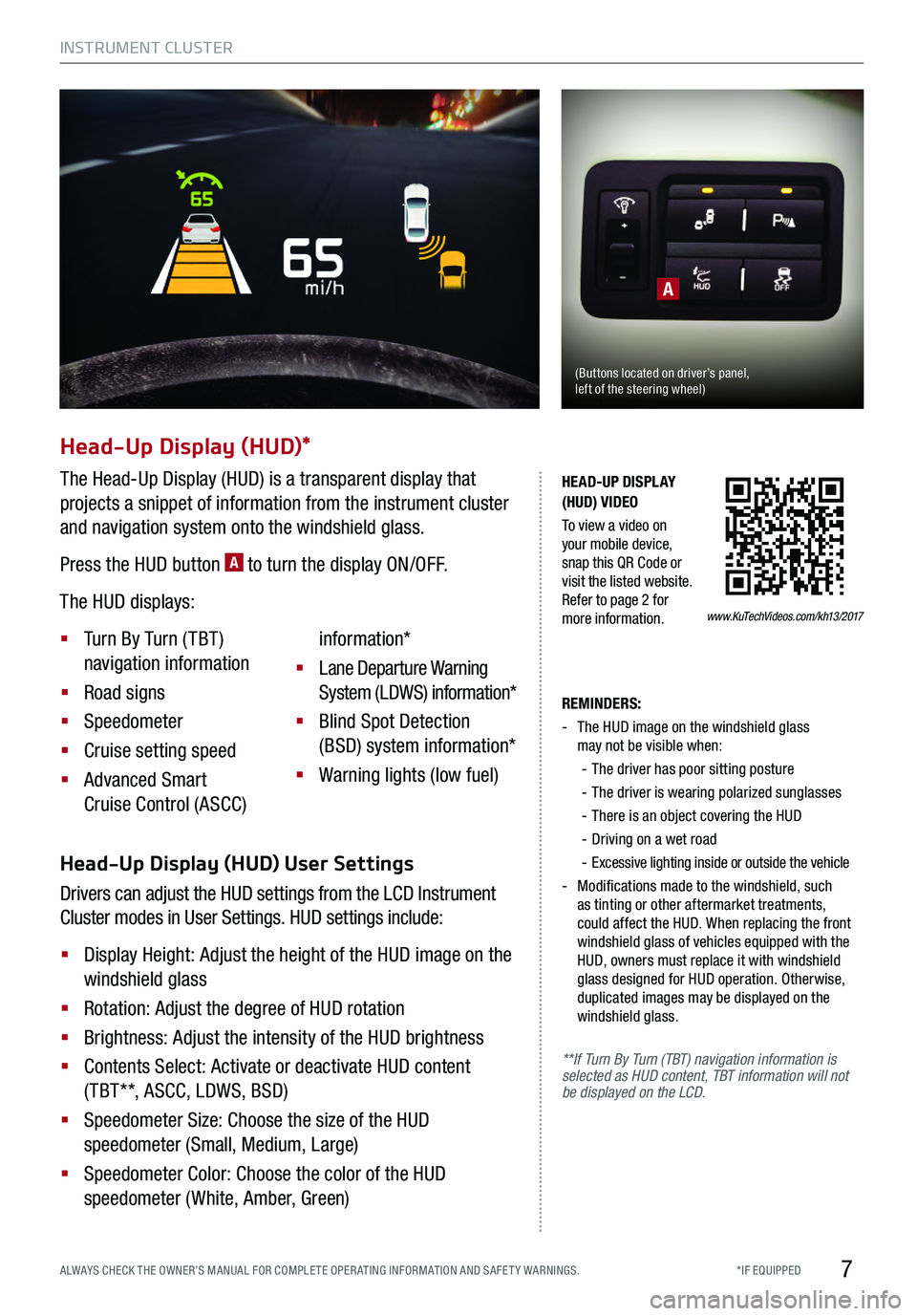
7
REMINDERS:
- The HUD image on the windshield glass
may not be visible when:
- The driver has poor sitting posture
- The driver is wearing polarized sunglasses
- There is an object covering the HUD
-Driving on a wet road
-Excessive lighting inside or outside the vehicle
- Modifications made to the windshield, such as tinting or other aftermarket treatments,
could affect the HUD. When replacing the front
windshield glass of vehicles equipped with the
HUD, owners must replace it with windshield
glass designed for HUD operation. Otherwise,
duplicated images may be displayed on the
windshield glass.
**If Turn By Turn (TBT) navigation information is
selected as HUD content, TBT information will not
be displayed on the LCD.
Head-Up Display (HUD) User Settings
Drivers can adjust the HUD settings from the LCD Instrument
Cluster modes in User Settings. HUD settings include:
§
Display Height: Adjust the height of the HUD image on the
windshield glass
§ Rotation: Adjust the degree of HUD rotation
§ Brightness: Adjust the intensity of the HUD brightness
§ Contents Select: Activate or deactivate HUD content
( TBT**, ASCC, LDWS, BSD)
§ Speedometer Size: Choose the size of the HUD
speedometer (Small, Medium, Large)
§ Speedometer Color: Choose the color of the HUD
speedometer (White, Amber, Green)
Head-Up Display (HUD)*
The Head-Up Display (HUD) is a transparent display that
projects a snippet of information from the instrument cluster
and navigation system onto the windshield glass.
Press the HUD button
A to turn the display ON/OFF.
The HUD displays:
§
Turn By Turn ( TBT )
navigation information
§
Road signs
§
Speedometer
§
Cruise setting speed
§
Advanced Smart
Cruise Control (ASCC) information*
§
Lane Departure Warning
System (LDWS) information*
§
Blind Spot Detection
(BSD) system information*
§
Warning lights (low fuel)
A
(Buttons located on driver’s panel, left of the steering wheel)
www.KuTechVideos.com/kh13/2017
HEAD-UP DISPLAY
(HUD) VIDEO
To view a video on
your mobile device,
snap this QR Code or
visit the listed website.
Refer to page 2 for
more information.
INSTRUMENT CLUSTER
*IF EQUIPPED
ALWAYS CHECK THE OWNER’S MANUAL FOR COMPLE TE OPER ATING INFORMATION AND SAFE T Y WARNINGS.
Page 10 of 62
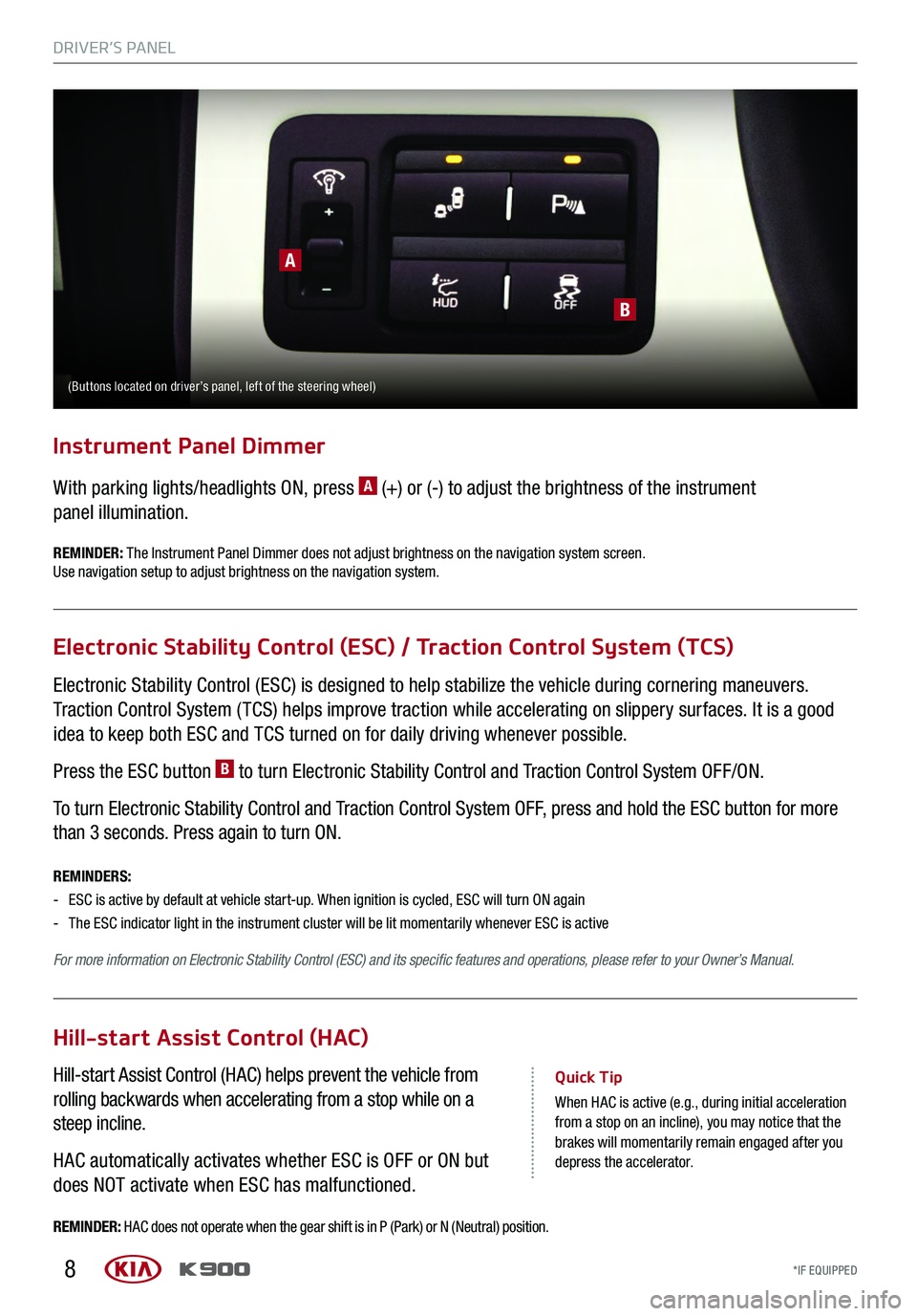
8
Electronic Stability Control (ESC) is designed to help stabilize the vehicle during cornering maneuvers.
Traction Control System ( TCS) helps improve traction while accelerating on slippery surfaces. It is a good
idea to keep both ESC and TCS turned on for daily driving whenever possible.
Press the ESC button
B to turn Electronic Stability Control and Traction Control System OFF/ON.
To turn Electronic Stability Control and Traction Control System OFF, press and hold the ESC button for more
than 3 seconds. Press again to turn ON.
Electronic Stability Control (ESC) / Traction Control System (TCS)
REMINDERS:
- ESC is active by default at vehicle start-up. When ignition is cycled, ESC will turn ON again
- The ESC indicator light in the instrument cluster will be lit momentarily whenever ESC is active
For more information on Electronic Stability Control (ESC) and its specific features and operations, please refer to your Owner’s Manual.
Hill-start Assist Control (HAC)
Hill-start Assist Control (HAC) helps prevent the vehicle from
rolling backwards when accelerating from a stop while on a
steep incline.
HAC automatically activates whether ESC is OFF or ON but
does NOT activate when ESC has malfunctioned.Quick Tip
When HAC is active (e.g., during initial acceleration from a stop on an incline), you may notice that the
brakes will momentarily remain engaged after you
depress the accelerator.
REMINDER: HAC does not operate when the gear shift is in P (Park) or N (Neutral) position.
With parking lights/headlights ON, press A (+) or (-) to adjust the brightness of the instrument
panel illumination.
Instrument Panel Dimmer
REMINDER: The Instrument Panel Dimmer does not adjust brightness on the navigation system screen.
Use navigation setup to adjust brightness on the navigation system.
A
B
(Buttons located on driver’s panel, left of the steering wheel)
DRIVER’S PANEL
*IF EQUIPPED
DRIVER’S PANEL
*IF EQUIPPED
Page 11 of 62
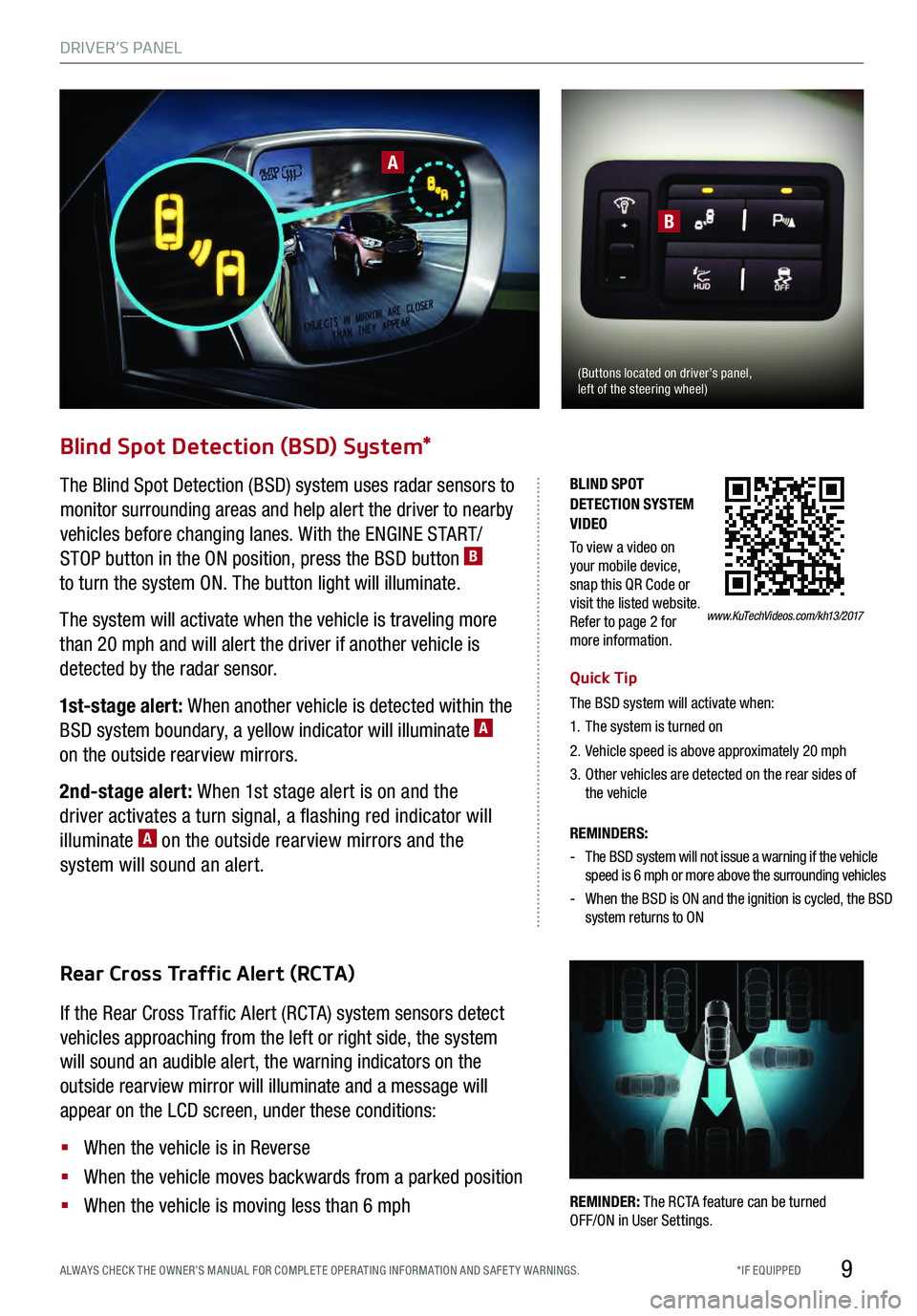
9
www.KuTechVideos.com/kh13/2017
BLIND SPOT
DETECTION SYSTEM
VIDEO
To view a video on
your mobile device,
snap this QR Code or
visit the listed website.
Refer to page 2 for
more information.
Blind Spot Detection (BSD) System*
The Blind Spot Detection (BSD) system uses radar sensors to
monitor surrounding areas and help alert the driver to nearby
vehicles before changing lanes. With the ENGINE START/
STOP button in the ON position, press the BSD button
B
to turn the system ON. The button light will illuminate.
The system will activate when the vehicle is traveling more
than 20 mph and will alert the driver if another vehicle is
detected by the radar sensor.
1st-stage alert: When another vehicle is detected within the
BSD system boundary, a yellow indicator will illuminate
A
on the outside rearview mirrors.
2nd-stage alert: When 1st stage alert is on and the
driver activates a turn signal, a flashing red indicator will
illuminate
A on the outside rearview mirrors and the
system will sound an alert.
Rear Cross Traffic Alert (RCTA)
If the Rear Cross Traffic Alert (RCTA) system sensors detect
vehicles approaching from the left or right side, the system
will sound an audible alert, the warning indicators on the
outside rearview mirror will illuminate and a message will
appear on the LCD screen, under these conditions:
§
When the vehicle is in Reverse
§
When the vehicle moves backwards from a parked position
§
When the vehicle is moving less than 6 mphREMINDER: The RCTA feature can be turned
OFF/ ON in User Settings .
A
B
Quick Tip
The BSD system will activate when:
1. The system is turned on
2. Vehicle speed is above approximately 20 mph
3. Other vehicles are detected on the rear sides of
the vehicle
REMINDERS:
- The BSD system will not issue a warning if the vehicle
speed is 6 mph or more above the surrounding vehicles
- When the BSD is ON and the ignition is cycled, the BSD
system returns to ON
(Buttons located on driver’s panel,
left of the steering wheel)
DRIVER’S PANEL
*IF EQUIPPED
ALWAYS CHECK THE OWNER’S MANUAL FOR COMPLE TE OPER ATING INFORMATION AND SAFE T Y WARNINGS.
Page 14 of 62
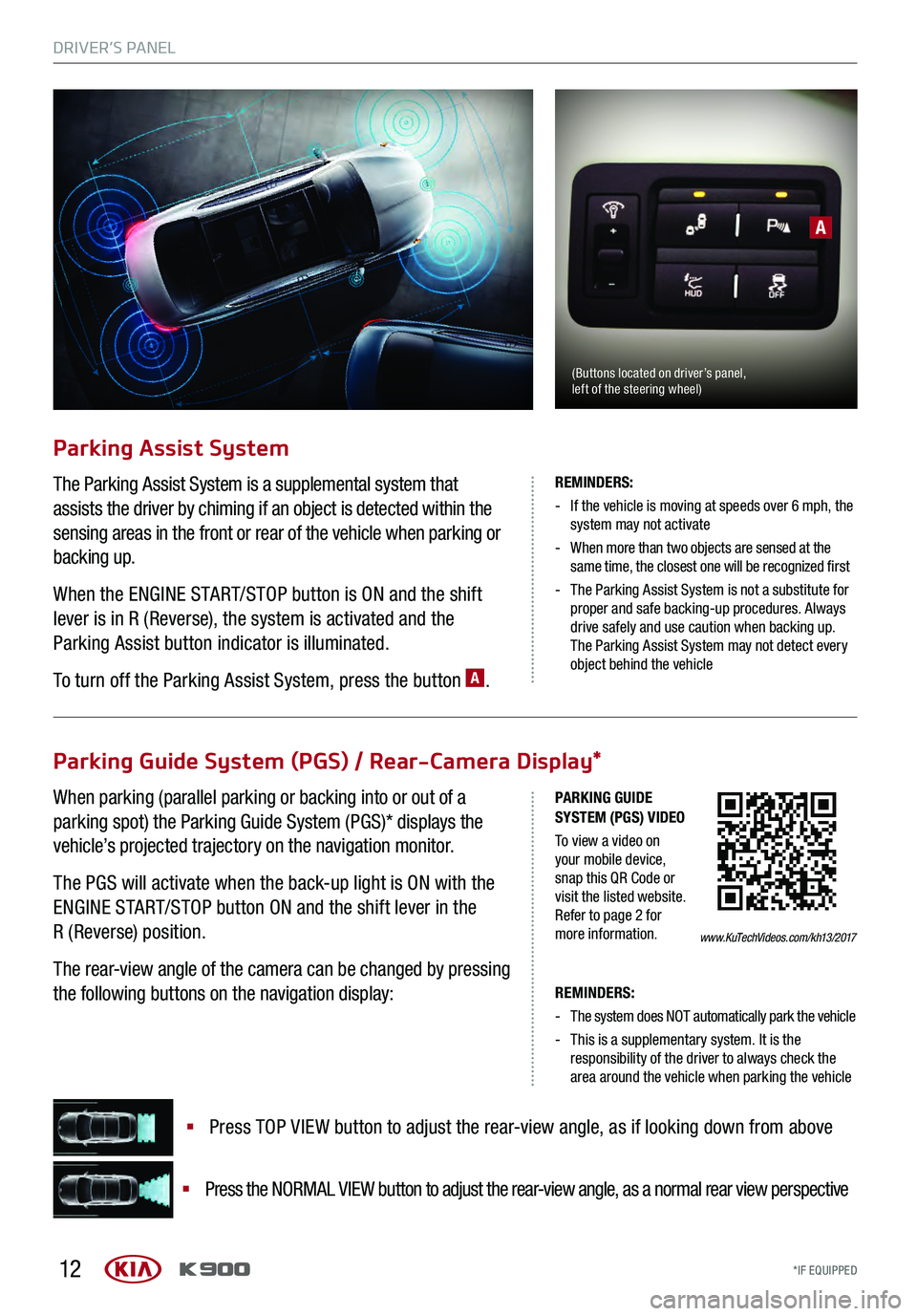
12
REMINDERS:
-The system does NOT automatically park the vehicle
- This is a supplementary system. It is the responsibility of the driver to always check the
area around the vehicle when parking the vehicle
Parking Guide System (PGS) / Rear-Camera Display*
§ Press TOP VIEW button to adjust the rear-view angle, as if looking down from above
§
Press the NORMAL VIEW button to adjust the rear-view angle, as a normal rear view perspective
www.KuTechVideos.com/kh13/2017
PARKING GUIDE
SYSTEM (PGS) VIDEO
To view a video on
your mobile device,
snap this QR Code or
visit the listed website.
Refer to page 2 for
more information.
The Parking Assist System is a supplemental system that
assists the driver by chiming if an object is detected within the
sensing areas in the front or rear of the vehicle when parking or
backing up.
When the ENGINE START/STOP button is ON and the shift
lever is in R (Reverse), the system is activated and the
Parking Assist button indicator is illuminated.
To turn off the Parking Assist System, press the button
A.
Parking Assist System
A
REMINDERS:
- If the vehicle is moving at speeds over 6 mph, the system may not activate
- When more than two objects are sensed at the same time, the closest one will be recognized first
- The Parking Assist System is not a substitute for proper and safe backing-up procedures. Always
drive safely and use caution when backing up.
The Parking Assist System may not detect every
object behind the vehicle
When parking (parallel parking or backing into or out of a
parking spot) the Parking Guide System (PGS)* displays the
vehicle’s projected trajectory on the navigation monitor.
The PGS will activate when the back-up light is ON with the
ENGINE START/STOP button ON and the shift lever in the
R (Reverse) position.
The rear-view angle of the camera can be changed by pressing
the following buttons on the navigation display:
(Buttons located on driver’s panel,
left of the steering wheel)
DRIVER’S PANEL
*IF EQUIPPED
DRIVER’S PANEL
*IF EQUIPPED
Page 16 of 62

14
To start the engine:
1. Depress the brake pedal
2. Press the ENGINE START/STOP button while gear shift is
in P (Park)
To turn the engine OFF, press the ENGINE START/STOP
button while the gear shift is in P (Park).
To use the ENGINE START/STOP button, you must have the
Smart Key on your person or inside the vehicle.
Engine Start/Stop Button
www.KuTechVideos.com/kh13/2017
ENGINE STA RT/STOP
BUTTON AND
SMART KEY VIDEO
To view a video on
your mobile device,
snap this QR Code or
visit the listed website.
Refer to page 2 for
more information.
REMINDERS:
- If Smart Key fob battery is dead, you can still start the engine by pressing
the ENGINE START/STOP button with the Lock-button end of the Smart
Key. The Smart Key must contact the ENGINE START/STOP button directly,
at a right angle
- In an emergency situation while the vehicle is in motion, you are able to turn
the engine off and to the ACC position by pressing the ENGINE START/ STOP
button for more than 2 seconds or 3 times successively within 3 seconds
B
CA
Quick Tips
To use electrical accessories:
ACC position
- When in the OFF position A and without
depressing the brake pedal, press the ENGINE
START/STOP
button once. The ACC indicator will illuminate (amber) B.
To check warning light s:
ON position
- When already in the ACC position B and without
depressing the brake pedal, press the ENGINE
START/STOP button again. The ON indicator will
illuminate (red)
C.
- When in the OFF position A and without
depressing the brake pedal, press the ENGINE
START/STOP button twice. The ON indicator will
illuminate (red)
C.
Keeping the vehicle in ACC or ON position too long
can discharge the vehicle’s battery .
DRIVER’S PANEL
*IF EQUIPPED
DRIVER’S PANEL
*IF EQUIPPED
Page 18 of 62
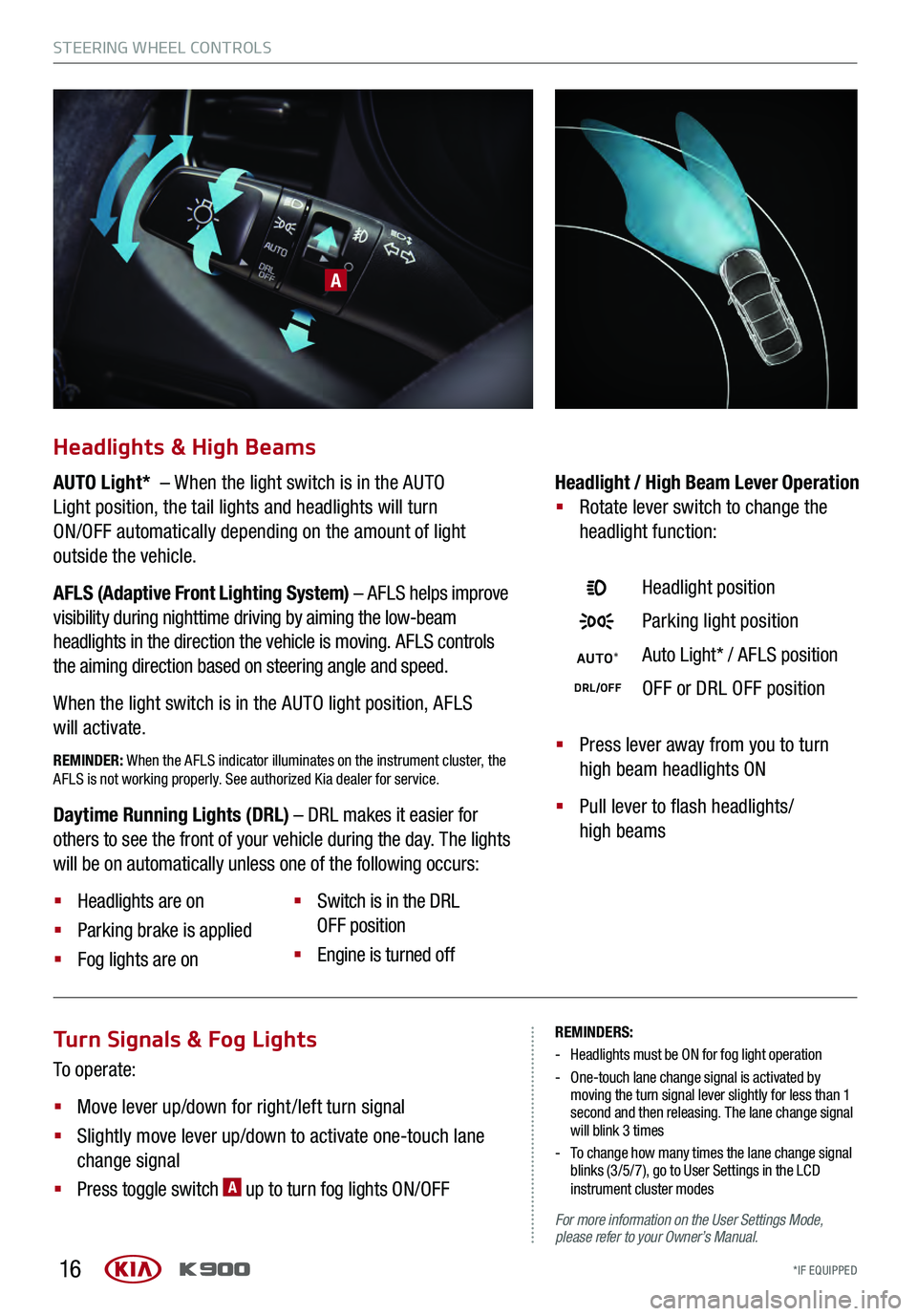
16
Turn Signals & Fog Lights
To operate:
§
Move lever up/down for right /left turn signal
§
Slightly move lever up/down to activate one-touch lane
change signal
§
Press toggle switch A up to turn fog lights ON/OFF
REMINDERS:
- Headlights must be ON for fog light operation
- One-touch lane change signal is activated by
moving the turn signal lever slightly for less than 1
second and then releasing. The lane change signal
will blink 3 times
- To change how many times the lane change signal blinks (3/5/7), go to User Settings in the LCD
instrument cluster modes
For more information on the User Settings Mode,
please refer to your Owner’s Manual.
A
Headlights & High Beams
AUTO Light* – When the light switch is in the AUTO
Light position, the tail lights and headlights will turn
ON/OFF automatically depending on the amount of light
outside the vehicle.
AFLS (Adaptive Front Lighting System) – AFLS helps improve
visibility during nighttime driving by aiming the low-beam
headlights in the direction the vehicle is moving. AFLS controls
the aiming direction based on steering angle and speed.
When the light switch is in the AUTO light position, AFLS
will activate.
REMINDER: When the AFLS indicator illuminates on the instrument cluster, the
AFLS is not working properly. See authorized Kia dealer for service.§ Press lever away from you to turn
high beam headlights ON
§
Pull lever to flash headlights/
high beams
Headlight / High Beam Lever Operation
§
Rotate lever switch to change the
headlight function:
Headlight position
Parking light position
AUTO *Auto Light* / AFLS position
DRL/OFFOFF or DRL OFF position
Daytime Running Lights (DRL) – DRL makes it easier for
others to see the front of your vehicle during the day. The lights
will be on automatically unless one of the following occurs:
§ Headlights are on
§ Parking brake is applied
§ Fog lights are on §
Switch is in the DRL
OFF position
§ Engine is turned off
STEERING WHEEL CONTROLS
*IF EQUIPPED
STEERING WHEEL CONTROLS
*IF EQUIPPED